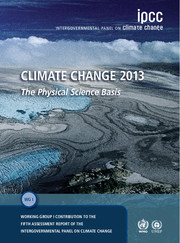 Climate Change 2013 – The Physical Science Basis
Climate Change 2013 – The Physical Science Basis Book contents
- Frontmatter
- Foreword, Preface and Dedication
- Contents
- Summary for Policymakers
- Technical Summary
- Chapters
- Chapter 1 Introduction
- Chapter 2 Observations: Atmosphere and Surface
- Chapter 3 Observations: Ocean Pages
- Chapter 4 Observations: Cryosphere
- Chapter 5 Information from Paleoclimate Archives
- Chapter 6 Carbon and Other Biogeochemical Cycles
- Chapter 7 Clouds and Aerosols
- Chapter 8 Anthropogenic and Natural Radiative Forcing
- Chapter 9 Evaluation of Climate Models
- Chapter 10 Detection and Attribution of Climate Change: from Global to Regional
- Chapter 11 Near-term Climate Change: Projections and Predictability
- Chapter 12 Long-term Climate Change: Projections, Commitments and Irreversibility Pages 1029 to 1076
- Chapter 13 Sea Level Change
- Chapter 14 Climate Phenomena and their Relevance for Future Regional Climate Change
- Annexes
- Index
Chapter 3 - Observations: Ocean Pages
Published online by Cambridge University Press: 05 June 2014
- Frontmatter
- Foreword, Preface and Dedication
- Contents
- Summary for Policymakers
- Technical Summary
- Chapters
- Chapter 1 Introduction
- Chapter 2 Observations: Atmosphere and Surface
- Chapter 3 Observations: Ocean Pages
- Chapter 4 Observations: Cryosphere
- Chapter 5 Information from Paleoclimate Archives
- Chapter 6 Carbon and Other Biogeochemical Cycles
- Chapter 7 Clouds and Aerosols
- Chapter 8 Anthropogenic and Natural Radiative Forcing
- Chapter 9 Evaluation of Climate Models
- Chapter 10 Detection and Attribution of Climate Change: from Global to Regional
- Chapter 11 Near-term Climate Change: Projections and Predictability
- Chapter 12 Long-term Climate Change: Projections, Commitments and Irreversibility Pages 1029 to 1076
- Chapter 13 Sea Level Change
- Chapter 14 Climate Phenomena and their Relevance for Future Regional Climate Change
- Annexes
- Index
Summary
Executive Summary
Temperature and Heat Content Changes
It is virtually certain that the upper ocean (above 700 m) has warmed from 1971 to 2010, and likely that it has warmed from the 1870s to 1971. Confidence in the assessment for the time period since 1971 is high based on increased data coverage after this date and on a high level of agreement among independent observations of subsurface temperature [3.2], sea surface temperature [2.4.2], and sea level rise, which is known to include a substantial component due to thermal expansion [3.7, Chapter 13]. There is less certainty in changes prior to 1971 because of relatively sparse sampling in earlier time periods. The strongest warming is found near the sea surface (0.11 [0.09 to 0.13]°C per decade in the upper 75 m between 1971 and 2010), decreasing to about 0.015°C per decade at 700 m. It is very likely that the surface intensification of this warming signal increased the thermal stratification of the upper ocean by about 4% between 0 and 200 m depth. Instrumental biases in historical upper ocean temperature measurements have been identified and reduced since AR4, diminishing artificial decadal variation in temperature and upper ocean heat content, most prominent during the 1970s and 1980s. {3.2.1–3.2.3, Figures 3.1, 3.2 and 3.9}
It is likely that the ocean warmed between 700 and 2000 m from 1957 to 2009, based on 5-year averages.
- Type
- Chapter
- Information
- Climate Change 2013 – The Physical Science BasisWorking Group I Contribution to the Fifth Assessment Report of the Intergovernmental Panel on Climate Change, pp. 255 - 316Publisher: Cambridge University PressPrint publication year: 2014
- 114
- Cited by
